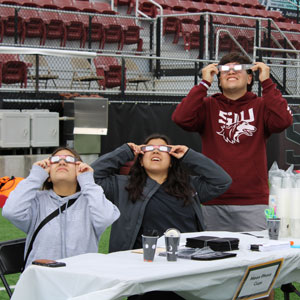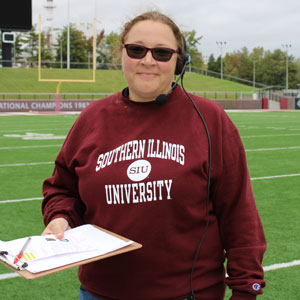
The so-called “ring of fire” presents itself on the big screen at Saluki Stadium during the annular eclipse on Oct. 14. (Photo provided) Below: Eclipse enthusiasts use glasses to view the annular eclipse Oct. 14 at Saluki Stadium. (Photo provided) Cori Brevik, assistant professor of practice in the School of Physics and Applied Physics, is leading a team of researchers from SIU and Adler Planetarium in Chicago on the REAL field trip project, funded by a two-year, $465,000 grant from the National Science Foundation. (Photo provided)
December 11, 2023
SIU researchers lead $465K project to bring 2024 eclipse to schools outside moon’s shadow
CARBONDALE, Ill. – Young students in Southern Illinois will have their second chance to witness an awe-inspiring total solar eclipse, being fortunate enough to live near its path. Faculty at Southern Illinois University Carbondale, however, are planning to bring the celestial event to many other youngsters who are not in the shadow this time around.
Faculty researchers have planned a project called the REAL Field Trip Model, which is aimed at pioneering a way to allow any school, regardless of location, to actively participate in large-scale scientific events such as space launches, aquarium and zoo events, volcanic eruptions, turtle hatchings and so on. REAL stands for Remote Engagement and Access to Learning.
Cori Brevik, assistant professor of practice in the School of Physics and Applied Physics, is leading a team of researchers from SIU and Adler Planetarium in Chicago on the project, which is funded by a two-year, $465,000 grant from the National Science Foundation.
“The big picture goal of the project is to create a model by which students who are not located near a big scientific event can still have an opportunity to experience the event firsthand in an interactive manner,” Brevik said. “The total solar eclipse is an example of an event that many students across the U.S. will not be able to witness firsthand because they are not in the path of totality.”
Brevik, along with SIU researchers Harvey Henson, Bob Baer and Karla Berry, as well as Michelle Nichols from the Adler Planetarium, will develop and assess the effort. The group conducted a trial run at Saluki Stadium during the annular eclipse on Oct. 14, 2023, and plans to have the effort fully operational on April 8, 2024, when the next total solar eclipse swings across North America into the Southern Illinois area.
Bringing the experience home
To measure the success of the project, the team is partnering with three middle schools in the path of totality, as well as three middle schools outside the path of totality. Following the eclipse, the researchers will compare the experiences of each group of students to determine how close they came to giving the out-of-path students the same experience as those in the eclipse path.
 To achieve this parity, the team is relying on readily available technology with a twist and a personal touch.
To achieve this parity, the team is relying on readily available technology with a twist and a personal touch.
Leading up to the eclipse, all of the students involved in the project will study the event and receive a visit from Adler Planetarium staff. The students also will have the option to create recorded reports, broadcasts and video logs to upload and share from an SIU website.
During the eclipse, the out-of-path students will watch the livestream show coming from SIU's Saluki Stadium, including watching images of the eclipse as it occurs in real-time. They also will watch interviews with experts and guided viewing discussions that will help them interpret events as they unfold.
At the same time, an in-the-path school will be paired with each out-of-path school, helping students share their experiences over interactive video conferencing.
“We hope to give the students both the personal experience as well as the group experience that comes with observing a total solar eclipse,” Brevik said. “It will be much more than just watching a video or livestream of an event.”
Annular eclipse testing
Brevik said the team tested some concepts and technology during the annular eclipse that hit the southwest United States on Oct. 14. During the test, the team placed several telescopes in the path of the annular eclipse and practiced pulling in live feeds and maintaining views of the event on the big screen on the north end of the football field and on SIU’s YouTube channel.
“It was a very successful test of the equipment and broadcasting network,” Brevik said. “For the total solar eclipse, we’ll expand it to include more telescopes and more viewing locations, all pulled together to share with schools.”
Expanding the network
For the total eclipse in April, the team plans to tap into about 70 telescopes spread across North America as part of the Dynamic Eclipse Broadcast Initiative network. Led by SIU researchers Baer and Matt Penn, the DEB Initiative is a citizen science project with teams composed of amateur astronomers, college students and high school and middle school students using telescopes to provide critical coronal data as the moon’s shadow traverses the continent.
 Some DEB telescopes will be designated to broadcast images as part of the livestream that will be produced by SIU, allowing those who tune in to watch the eclipse from its first contact in Mexico across the United States and into Canada. The live images will be interspersed with interviews from solar experts, eclipse chasers and more.
Some DEB telescopes will be designated to broadcast images as part of the livestream that will be produced by SIU, allowing those who tune in to watch the eclipse from its first contact in Mexico across the United States and into Canada. The live images will be interspersed with interviews from solar experts, eclipse chasers and more.
Other segments will guide the viewer through events as they occur and provide information about what people should be looking for at any given time. The livestream will be available for anyone who wishes to tune in and avoid any inclement weather issues, with its reliance on a network of telescopes across a wide region and not just one location.
